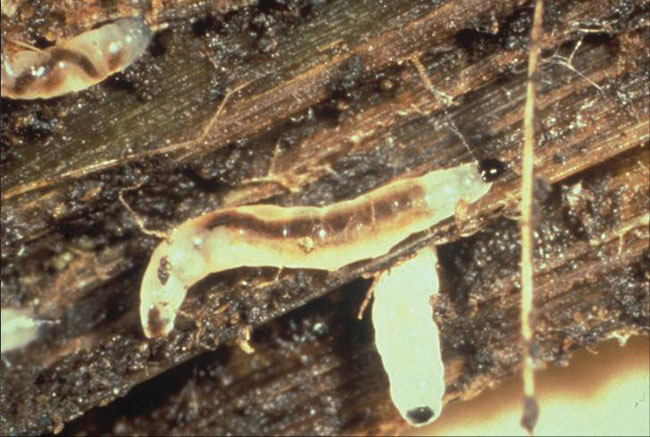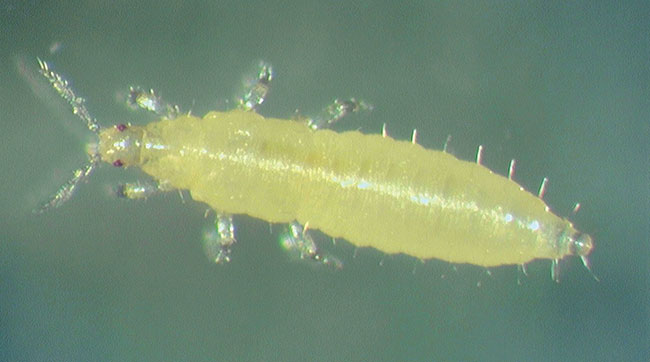
Dr. Bugs: Entomopathogenic Fungi
Answer: You ask a really good question that is important in the management of insect pests in greenhouse production systems when using entomopathogenic fungal- based insecticides. First, you need to know that the insect cuticle (skin) provides protection from desiccation (drying up) and serves as a defense against biological control agents (parasitoids and predators). The cuticle surface
is also where entomopathogenic fungi, such as Beauveria bassiana, Isaria fumosoroseus and Metarhizium brunneum, attach to the body of insect pests such as aphids, mealybugs, thrips, and whiteflies. Infection of insect pests begins after conidia (asexually produced spores) of an entomopathogenic fungus attaches to the cuticle.
After attaching to the insect cuticle, entomopathogenic fungi produce degradation enzymes, such as proteases, chitinases and lipases, as well as secondary metabolites that permit direct penetration through the insect pest cuticle, which facilitates an infection. Infection by entomopathogenic fungi is associated with germination and growth of a fungus on the surface of the insect pest cuticle, which allows the fungal hyphae (branching filaments that constitute the mycelium of a fungus) to directly penetrate through the cuticle layers. The fungus then produces a specialized structure called an appressorium that allows the growing hyphae to create mechanical pressure, which weakens the cuticle and facilitates infection or entry into the body of an insect pest. Therefore, infection by an entomopathogenic fungus involves: 1) attachment of conidia to the insect pest cuticle, 2) germination or germ tube formation, and 3) penetration through the insect pest cuticle.
However, insect pests have developed several mechanisms that can inhibit infection by entomopathogenic fungi, including: 1) production of antimicrobial compounds in the cuticle that inhibit fungal attachment and decrease infection, 2) shedding of the cuticle when molting (ecdysis), and 3) implementing behavioral responses such as grooming and burrowing.

The antimicrobial compounds produced by the cuticle can inhibit spore germination and growth of hyphae, thus suppressing the ability of an entomopathogenic fungus to enter the insect pest body. In addition, compounds in the cuticle can resist mechanical penetration or inhibit fungal degradation enzymes.
Molting mitigates infection by an entomopathogenic fungus by reducing the time that an entomopathogenic fungus can infect an insect pest. For example, the molting of aphids and thrips may contribute to insufficient mortality when using entomopathogenic fungal-based insecticides, such as BotaniGard, Ancora, and Met52.
Some insect pests groom themselves, which removes fungal spores from the cuticle and reduces infection. In addition, tunneling or burrowing into the growing medium may result in removing fungal spores (e.g., fungus gnat larvae and western flower thrips, Frankliniella occidentalis, second instar larvae or adults when entering or emerging from the growing medium).
All three mechanisms described above can reduce the ability of an entomopathogenic fungus to infect insect pests, thus decreasing their effectiveness in managing insect pest populations.

The cuticle can vary depending on the specific life stage (larva, nymph and adult) of an insect pest. For example, the larvae and adult life stages of western flower thrips are susceptible to infection by most entomopathogenic fungi. However, adult western flower thrips are more susceptible to infection by entomopathogenic fungi than the larvae. The difference in life stage susceptibility may be associated with the removal of fungal spores that are attached to the cuticle surface when western flower thrips larvae shed their outer cuticle during molting. As such, entomopathogenic fungi that are unable to penetrate the cuticle before the onset of molting will not infect western flower thrips. In addition, the larvae have a thicker cuticle, which may decrease penetration, thus rendering the larvae more resistant to infection.
A way to overcome insect pests removing fungal spores during molting, and subsequently enhancing the effectiveness of an entomopathogenic fungus, is to combine an entomopathogenic fungal-based insecticide with an insecticide product that contains the insect growth regulator azadirachtin (AzaGuard, Azatin, Azatrol, Ornazin, and Molt-X). Azadirachtin is an ecdysone antagonist. Ecdysone is the juvenile hormone that is responsible for initiating molting. Azadirachtin delays the molting process by inhibiting the production of ecdysone. Consequently, by delaying the molting process, the entomopathogenic fungus can penetrate the cuticle and infect an insect pest before molting occurs. However, the synergistic effect of using azadirachtin in conjunction with an entomopathogenic fungus may not occur for all entomopathogenic fungi.
Entomopathogenic fungi are effective in managing insect pest populations when applied early in the production cycle and when insect pest populations are low. However, infection and subsequent mortality take longer (in days) than most commonly used insecticides.
Figure 1 Above: Aphid molting skins. Molting or shedding of the cuticle may protect aphids from infection by an entomopathogenic fungus.
Raymond A. Cloyd is professor and extension specialist in horticultural entomology/plant protection at Kansas State University. He can be reached at rcloyd@ksu.edu.


 Video Library
Video Library 




















